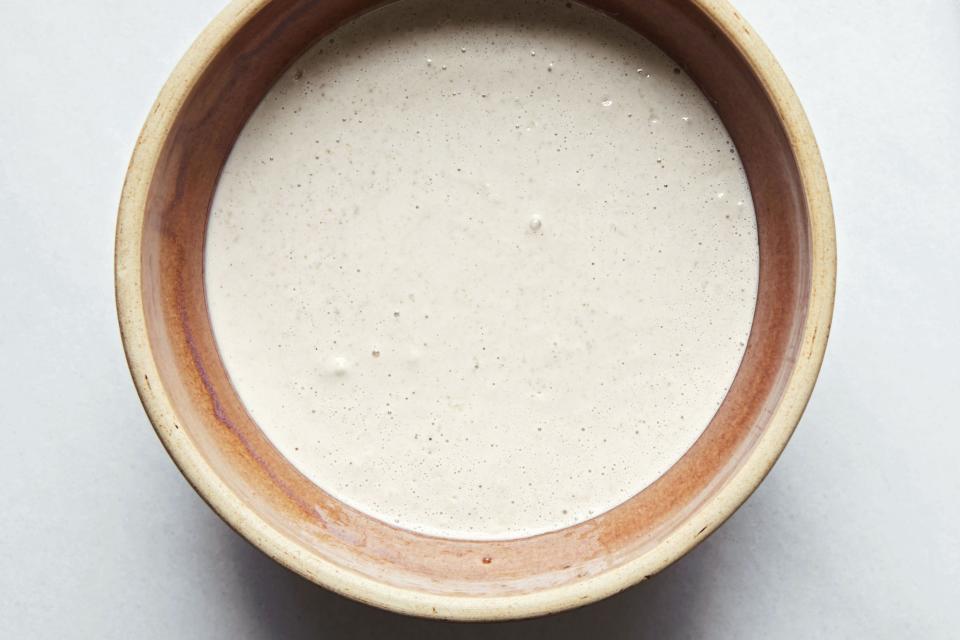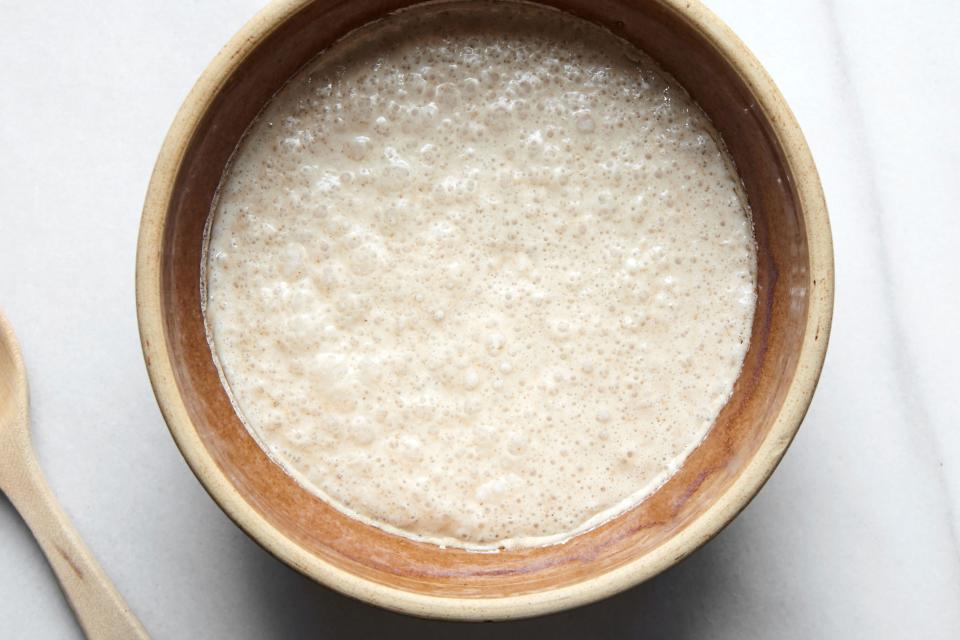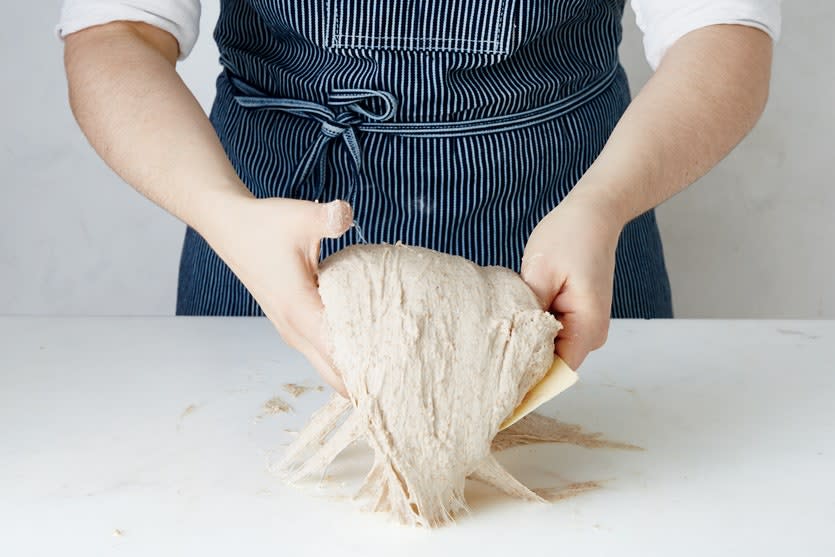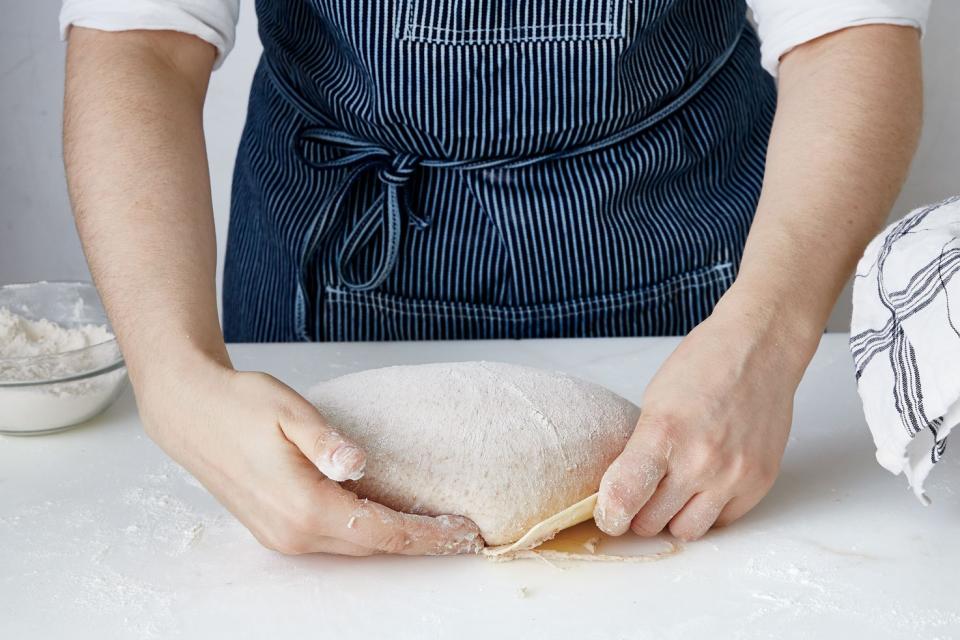Troubleshooting Sourdough: 18 Questions Novice Bakers Are Asking About Their New Favorite Hobby
With new hobbies comes new questions. And with the skyrocketing interest in sourdough bread baking lately, the number of people wondering why their bread isn’t turning out the way they’d hoped is on the rise too.
That’s why I recently chatted with Evrim Dogu, co-owner and head bread baker at Sub Rosa in Richmond, Virginia; as well as cookbook author Josey Baker (yes, that’s his real last name) of Josey Baker Bread in San Francisco to discuss some of the biggest pitfalls novice sourdough bakers face.
Below, you'll find their answers to these questions and more, plus their best tips, tales of their own fledgling baking days, and the secrets they wish someone had told them sooner.
What kind of flour should I use to feed my starter?
BAKER: I prefer whole-grain rye flour, but it's not essential. Any flour can do. I've had the best luck starting cultures from fresh milk and whole-grain rye flour. But plenty of people have had success starting and keeping a culture going with every variety of flour.
DOGU: At Sub-Rosa we use 50/50 whole wheat and sifted wheat [such as white bread flour or all-purpose flour]. What’s more important is to use the highest quality flour and water you can—it's only two ingredients. If you have access to non-chlorinated spring water that already has some minerals in it: great! If not, filtered water is great.
As for flour: if you can get organic, that’s better. If you can get stone-ground flour, better. It's good to use a little bit of whole grain because it ferments faster.
Plus, the character of the grain comes through so much in fermentation. Just like with anything that ferments, you kind of get this intensification of the flavor profile—spelt is super nutty and sweet, rye is spicy and peppery, einkorn is nutty and almost cheesy. Switching the grain in your starter is a cool place to play around with flavors.
How sourdough really works—and what to do with your discard.
Why is my sourdough starter runny?
DOGU: It's very important a baker understands the hydration of their starter. Baker's Formula 101 is always based on flour, where flour is 100% and everything against the flour is a percentage of that number. So if I told you that I have 100 grams of flour and 70 grams of water, that's 70% hydration.
A lot of people starting out use an equal volume of flour and water because it’s easy, but it's also a lot harder to tell when it’s ready, versus a starter that's a little stiffer: say, around 70% hydration. If you add too much water, you might not see that your starter has already leavened and now it’s collapsed again, making it appear runny.
BAKER: They’re probably using too much water—although, a runny starter is not necessarily a bad thing.
DOGU: Wetter doughs and starters ferment faster—that's a good little rule to note.
How often do I have to feed my starter?
BAKER: If you want to be baking regularly, you should feed your starter every day. If you don't want to be baking regularly, so long as it’s healthy and active, you can get away with feeding your starter once every one to two weeks—but in that case, it should be living in your refrigerator.
EPI: Evrim, you mentioned using filtered water. If someone keeps their filter in the fridge, is it okay to feed your starter with cold water?
DOGU: If you're going to keep your starter in a warmer spot and you're feeding it overnight, then it’s fine to use cold water—you're leaving it for 12 hours before you plan to use it, right? But if you want to make bread in an hour and you feed your starter with cold water, an hour later your starter is going to look the same.
The ideal temperature for yeast to populate is around 78°F; feeding your starter with warmer water means it will populate more quickly.

Sourdough Starter Under Proofed - INSET

Sourdough Stater - INSET
Why isn’t my sourdough starter bubbling?
DOGU: So if you feed a starter and you don't notice it doubling or tripling, and you don't notice it bubbling, you probably just haven't waited long enough. That or the place you’re storing it could be too cold.
Fermentation is just time and temperature. You want to make sure there are no radical changes in temperature—that means aiming for like upper-70s/lower-80s. And you want to aim for regular feedings. A lot of sourdough recipes will say “feed every 24 hours.” That doesn't mean you have to feed it at 6:59pm every day on the dot, but it should probably be within the same hour each day that you're discarding and feeding.
And if something hasn't happened in a week, then you might be doing something wrong. Like: you have soap in the dish, or something else might be competing with the yeast. Once somebody feeds their starter on a regular schedule, they'll usually start to notice action within five or six days.
EPI: So in terms of staying regular with it, would you say that also applies to the amount of starter you're discarding and the amount of fresh flour and water you're adding back, as well as the type of flour you're using?
DOGU: Absolutely. If this is like your first time experimenting with sourdough, you want to minimize the variables as much as possible.
Why does sourdough starter stink?
DOGU: That's a subjective term, right? Generally speaking, early on in the starter’s fermentation, it should smell very, very good. If you just fed your starter, it should pretty much smell like fresh pancake batter, you know, just kind of clean wheat.
When it's really fermented, I like to quote Daniel Leader's book Local Breads: he talks about “the smell of overripe fruit,” and that is very right on. So, not rotting, but overripe—like that smell where the banana is kinda falling apart, or an apple is a little sore, a pear is getting mushy.
When a starter is breaking down, you might smell some kind of acid—a lime or lemon aroma is not uncommon, or even a light vinegar smell. But it shouldn’t smell too much like that.
Also, if it was at the right temperature and the timing is right, you'll get lactic fermentation—so cheesy or tangy yogurt smells are all positive. Stiffer starters tend to smell a little bit more of tropical fruit. Starters that are a little wetter usually have a little bit more of that high acid smell.
What starter should not smell like is human gas—that’s a sign there could be bad bacteria in there. If your starter smells like a fart, it probably needs to be fed more regularly, or you missed the window and now it’s over-fermented.
You also have to remember that this is like an animal you’re feeding and if you change its food—if you change the flour or the temperature—it will affect the smell and flavor of your sourdough.
BAKER: Yeah: beer, yogurt, ripe fruit. I think once it starts to smell bad, you can really trust your gut. If you are repulsed—like strongly repulsed—by your starter, it's not that your sourdough is dead or needs to be discarded. It's just very unhealthy and needs to be fed more regularly.
What is this grey liquid on top of my starter?
DOGU: That usually happens when people leave their sourdough starter in the fridge for a long time and forget about it. It’s called “hooch.” It’s alcohol, which kills yeast. Just pour it off.
BAKER: I think one of the biggest mistakes people make is throwing out starter that smells or looks off. People who don't have much experience with sourdough assume starter is more fragile than it actually is. Starters are easy to make unhappy, but they’re very hard to kill.
If your starter looks weird or smells weird, it almost always means your starter is unhealthy because you've been neglecting it. All you need to do is go through a standard feeding: once a day for maybe a week or so, and it should be back to its healthy self.
EPI: So how much would you say a home baker’s standard feeding should be?
BAKER: What I tell people now is that you want to discard all but a teaspoon of your starter and add a heaping tablespoon of flour and a tablespoon of warm water. That is a new reduced-quantity feeding protocol to use since flour is in such short supply.
You know, you’re usually instructed to feed your starter ½ cup or a whole cup of flour. Doing that, you just end up burning through a lot of flour, and it's unnecessary to keep it healthy.
But yeah, do a good feeding every day for a week, and at the end of it, if it's still acting weird, then you can ditch it and start over, or find a new feed culture.
Be your own boulangerie.
Why did my sourdough starter explode?
DOGU: That’s a great problem to have. It means your starter is very active, but it was probably ready like one or two hours ago. If it’s overflowing, you’re using too small of a vessel—when a starter is ready it can almost double in size.
How do I know sourdough starter is ready for making bread?
BAKER: You’re really looking for the appearance of bubbles and smell. Bubbles are evidence of yeast activity and smell is evidence of bacterial activity, right? Sourdough starter is wild yeast and bacteria.
Within eight to 12 hours of feeding your starter, you want to see a noticeable increase in volume and it should be putting off a pretty pungent smell: some combination of yogurt and vinegar aromas.
DOGU: I can not overstate this enough: do not use a starter in bread until you’re sure it’s ready. It’s something I wish somebody had told me in my home-baking days.
One of the best ways to be very sure it's ready is when you quickly pinch it—it's hard because sometimes when you pinch it, it'll de-gas it enough that it won't float; but, if you quickly take a pinch and place it in water, it should float. If it floats, you can be 100 percent sure it will leaven your bread. You've just proven the yeast have created enough CO2 that they can float in water.
If they're able to do that, and you put them in a dough and let it leaven to the same rate, then when we put that bread in the oven it's going to have enough CO2 to create the pockets everybody wants and make a nice, fluffy bread.
Why is my sourdough so sticky?
BAKER: In order to make really good bread, the dough is usually going to be a little bit tricky to handle. It might feel wet, but don't let that deter you. It's challenging, you know, you can't expect to have never handled sourdough before, and jump right in and be really good at it. Practice makes perfect, you know. Using some dry flour during the shaping phase is totally fine. That will help the dough not stick to your bench and to your hands.
DOGU: There's a reason we all love high-hydration bread. Those loaves last forever and they're delicious. Like when you heat them up and crack it open it’s almost like custard.
But I would tell a beginning baker to back off the hydration because if it’s sticking to everything and you’re throwing tons of flour at it, you're more likely to hurt the bread—that’s what’s gonna cause a dense, gummy crumb.

What Went Wrong with Your Sourdough - Kneading -INSET
Why did my sourdough not rise?
DOGU: If your starter was showing signs of activity, then you’re probably just not waiting long enough.
When you’re first starting, you might be kind of impatient or you're watching it all day because you're super into it. But it's really hard to appreciate how long it takes. That said, professionals tend to use a lot less starter in our bread because we’re feeding it three times a day and it’s very robust. We’re in an environment with a lot of wild yeast; while at home, you might be feeding your starter once a week.
If your starter is really ripe and ready—we're talking like 80°F the whole time—and you put it into your dough, mix it, and let it sit and give it your folds or whatever you're going to do, it should take around four to five hours for the bulk fermentation. Maybe three hours if it’s really raring to go and you put in a lot of starter (like 20 to 30 percent). After you shape the dough, it’ll take another couple hours.
So, if your starter is weaker or your bread is taking longer than a few hours to rise, you might want to increase the percentage of starter you’re adding to your bread.
How do I know when my sourdough has finished the first proofing/bulk fermentation?
DOGU: Use a container where you can see the height of the dough from the outside. When you finish mixing, put the dough in that container, and mark where the top of the dough is. The sourdough should reach at least 50 percent higher—so not doubled in size, but 50 percent larger in size before you want to shape it.
But know that the more whole grain you use, the less you can tell fermentation from volume. If you're using all white flour and your dough is fermenting, you'll really be able to see it. Same with the more water there is, you'll really be able to see it kind of bubble and rise up.
If you're working with a stiffer dough and using more whole grain, it's going to be fermenting kind of in a smaller map. The rise is not going to be as dramatic. It's not going to show off as much.
How do I know my shaped sourdough is ready for the oven?
DOGU: After you shape it, it should increase another 50 percent. And when you're shaping, especially for novice bakers, you want to do just a simple fold-and-tuck, handling the dough very gently, trying not to de-gas it too much.
Generally speaking, I’d say everybody needs to push their fermentation further—I think that's actually true of professionals too.
I mean, I don't have people coming to me and saying, “oh man, my bread was so light and fluffy!” It’s usually “my bread’s not bubbly, what’s going on?”
If you push the fermentation, you get so much more flavor and lightness and all the things that you want.

What Went Wrong with your Sourdough - Shaping - INSET
Why does my sourdough bread split when baking?
DOGU: Sourdough is supposed to split, but you should control it with a slash. If it splits on the bottom, you maybe didn’t slash it enough. Or possibly it wasn’t moist enough in the baking environment.
Why is my sourdough dense?
DOGU: This one is really difficult to troubleshoot because it could be a few different things.
BAKER: It’s most likely due to a not-active-enough sourdough starter. But it also could be due to improper hydration. You know, the unfortunate, complicated truth is that your dough could be over-hydrated or under-hydrated.
I feel like, more often than not, the issue is under-hydrated—meaning you didn't put enough water into the dough. If your dough is too stiff, basically that means it’s resistant to being blown up by the yeast.
DOGU: If your hydration is low, increase it. If that’s not it: did your starter pass the float test? Did you wait long enough when proofing your bread? A lot of times I find bakers just needed to wait hours longer before baking.
Why is my sourdough bread gummy?
BAKER: Sourdough can be gummy for a lot of different reasons. It's possibly under-baked. [Note: As a general rule, sourdough bread is done baking when an instant-read thermometer inserted into the center of the loaf reads between 200 to 210°F.]
Another common issue is that the sourdough starter wasn't really active enough. So the bread never got enough gas in it to actually rise up into an airy loaf.
How do I get really sour-tasting bread?
BAKER: The short answer is to start out with a very sour starter, which you get by letting it sit for a while. If you have a healthy starter, let it sit for a while, and allow a lot of time for the bulk fermentation, that's one way to get more acidity.
DOGU: When you put dough in the fridge, there's this period of time when the dough reaches about 60°F where the yeast are dormant, but the bacteria will still proliferate. That bacteria creates acetic acid, which is that vinegary, super-sour flavor. So one way to get more of that flavor is to do part of your fermentation in the refrigerator.
Sourdough is more than a recipe. It's a lifestyle, like CrossFit. Except, you know, the opposite.
How do I get big holes in my sourdough?
BAKER: Well, that's a very nuanced thing. You have to have a properly hydrated flour that's fermented well, shaped well, and baked well. So, basically, you need to do everything right.
Why doesn’t my bread taste like the ones in [insert name of famous bread city]?
DOGU: Scientists have done studies where they've taken starters from San Francisco or France. They feed them somewhere else and the yeast populations don't maintain. In other words, the yeast strains that are popularized in Paris or in San Francisco, they don’t thrive in, say, Richmond.
Yeast populations are really built on terroir.
EPI: Meaning the bread you’re making will have the flavors characteristic of the stains of wild yeast and bacteria native to the place you’re baking it?
DOGU: Right, and also what grain you’re using.
As much as people like to think of it romantically like, "this starter is 100 years old and it started in my grandfather's boots," really, every time you feed it and have a successful leavening, you're murdering millions of yeast and a new batch of yeast is growing. The yeast has to die and the new ones have to be born in order to have really good starter and that new yeast is going to take on the flavor of the place it's being cultivated.
Ready to dive into some bread recipes? Here are a few of our favorites.
Originally Appeared on Epicurious




